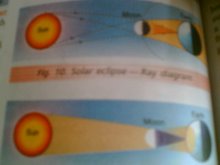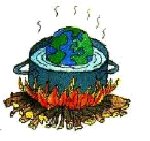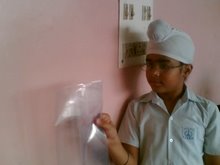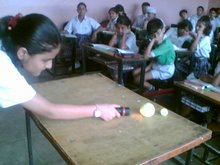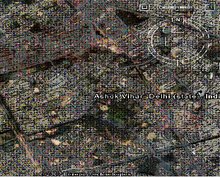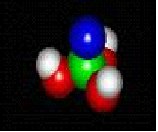Listen to the Exhortation of the Dawn!
Look to this Day!
For it is Life, the very Life of Life.
In its brief course lie all the
Verities and Realities of our Existence.
The Bliss of Growth,
The Glory of Action,
The Splendor of Beauty;
For Yesterday is but a Dream,
And To-morrow is only a Vision;
But To-day well lived makes
Every Yesterday a Dream of Happiness,
And every Tomorrow a Vision of Hope.
Look well therefore to this Day!
Such is the Salutation of the Dawn!
Keep doing good! Keep feeling good!
Wednesday, 11 February 2009
Sunday, 8 February 2009
solar eclipse
The Moon's Two Shadows
An eclipse of the Sun (or solar eclipse) can only occur at New Moon when the Moon passes between Earth and Sun. If the Moon's shadow happens to fall upon Earth's surface at that time, we see some portion of the Sun's disk covered or 'eclipsed' by the Moon. Since New Moon occurs every 29 1/2 days, you might think that we should have a solar eclipse about once a month. Unfortunately, this doesn't happen because the Moon's orbit around Earth is tilted 5 degrees to Earth's orbit around the Sun. As a result, the Moon's shadow usually misses Earth as it passes above or below our planet at New Moon. At least twice a year, the geometry lines up just right so that some part of the Moon's shadow falls on Earth's surface and an eclipse of the Sun is seen from that region.
The Moon's shadow actually has two parts:
1. Penumbra
The Moon's faint outer shadow.
Partial solar eclipses are visible from within the penumbral shadow.
2. Umbra
The Moon's dark inner shadow.
Total solar eclipses are visible from within the umbral shadow.
When the Moon's penumbral shadow strikes Earth, we see a partial eclipse of the Sun from that region. Partial eclipses are dangerous to look at because the un-eclipsed part of the Sun is still very bright. You must use special filters or a home-made pinhole projector to safely watch a partial eclipse of the Sun (see: Observing Solar Eclipses Safely).
What is the difference between a solar eclipse and a lunar eclipse? A lunar eclipse is an eclipse of the Moon rather than the Sun. It happens when the Moon passes through Earth's shadow. This is only possible when the Moon is in the Full Moon phase.
An eclipse of the Sun (or solar eclipse) can only occur at New Moon when the Moon passes between Earth and Sun. If the Moon's shadow happens to fall upon Earth's surface at that time, we see some portion of the Sun's disk covered or 'eclipsed' by the Moon. Since New Moon occurs every 29 1/2 days, you might think that we should have a solar eclipse about once a month. Unfortunately, this doesn't happen because the Moon's orbit around Earth is tilted 5 degrees to Earth's orbit around the Sun. As a result, the Moon's shadow usually misses Earth as it passes above or below our planet at New Moon. At least twice a year, the geometry lines up just right so that some part of the Moon's shadow falls on Earth's surface and an eclipse of the Sun is seen from that region.
The Moon's shadow actually has two parts:
1. Penumbra
The Moon's faint outer shadow.
Partial solar eclipses are visible from within the penumbral shadow.
2. Umbra
The Moon's dark inner shadow.
Total solar eclipses are visible from within the umbral shadow.
When the Moon's penumbral shadow strikes Earth, we see a partial eclipse of the Sun from that region. Partial eclipses are dangerous to look at because the un-eclipsed part of the Sun is still very bright. You must use special filters or a home-made pinhole projector to safely watch a partial eclipse of the Sun (see: Observing Solar Eclipses Safely).
What is the difference between a solar eclipse and a lunar eclipse? A lunar eclipse is an eclipse of the Moon rather than the Sun. It happens when the Moon passes through Earth's shadow. This is only possible when the Moon is in the Full Moon phase.
The Moon's Two Shadows
An eclipse of the Sun (or solar eclipse) can only occur at New Moon when the Moon passes between Earth and Sun. If the Moon's shadow happens to fall upon Earth's surface at that time, we see some portion of the Sun's disk covered or 'eclipsed' by the Moon. Since New Moon occurs every 29 1/2 days, you might think that we should have a solar eclipse about once a month. Unfortunately, this doesn't happen because the Moon's orbit around Earth is tilted 5 degrees to Earth's orbit around the Sun. As a result, the Moon's shadow usually misses Earth as it passes above or below our planet at New Moon. At least twice a year, the geometry lines up just right so that some part of the Moon's shadow falls on Earth's surface and an eclipse of the Sun is seen from that region.
The Moon's shadow actually has two parts:
1. Penumbra
The Moon's faint outer shadow.
Partial solar eclipses are visible from within the penumbral shadow.
2. Umbra
The Moon's dark inner shadow.
Total solar eclipses are visible from within the umbral shadow.
When the Moon's penumbral shadow strikes Earth, we see a partial eclipse of the Sun from that region. Partial eclipses are dangerous to look at because the un-eclipsed part of the Sun is still very bright. You must use special filters or a home-made pinhole projector to safely watch a partial eclipse of the Sun (see: Observing Solar Eclipses Safely).
What is the difference between a solar eclipse and a lunar eclipse? A lunar eclipse is an eclipse of the Moon rather than the Sun. It happens when the Moon passes through Earth's shadow. This is only possible when the Moon is in the Full Moon phase.
An eclipse of the Sun (or solar eclipse) can only occur at New Moon when the Moon passes between Earth and Sun. If the Moon's shadow happens to fall upon Earth's surface at that time, we see some portion of the Sun's disk covered or 'eclipsed' by the Moon. Since New Moon occurs every 29 1/2 days, you might think that we should have a solar eclipse about once a month. Unfortunately, this doesn't happen because the Moon's orbit around Earth is tilted 5 degrees to Earth's orbit around the Sun. As a result, the Moon's shadow usually misses Earth as it passes above or below our planet at New Moon. At least twice a year, the geometry lines up just right so that some part of the Moon's shadow falls on Earth's surface and an eclipse of the Sun is seen from that region.
The Moon's shadow actually has two parts:
1. Penumbra
The Moon's faint outer shadow.
Partial solar eclipses are visible from within the penumbral shadow.
2. Umbra
The Moon's dark inner shadow.
Total solar eclipses are visible from within the umbral shadow.
When the Moon's penumbral shadow strikes Earth, we see a partial eclipse of the Sun from that region. Partial eclipses are dangerous to look at because the un-eclipsed part of the Sun is still very bright. You must use special filters or a home-made pinhole projector to safely watch a partial eclipse of the Sun (see: Observing Solar Eclipses Safely).
What is the difference between a solar eclipse and a lunar eclipse? A lunar eclipse is an eclipse of the Moon rather than the Sun. It happens when the Moon passes through Earth's shadow. This is only possible when the Moon is in the Full Moon phase.
Subscribe to:
Comments (Atom)
































